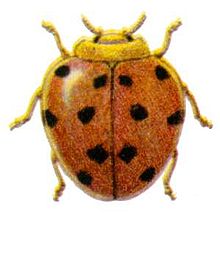| Henosepilachna sumbana | |
|---|---|
 | |
| Scientific classification | |
| Domain: | Eukaryota |
| Kingdom: | Animalia |
| Phylum: | Arthropoda |
| Class: | Insecta |
| Order: | Coleoptera |
| Suborder: | Polyphaga |
| Infraorder: | Cucujiformia |
| Family: | Coccinellidae |
| Genus: | Henosepilachna |
| Species: | H. sumbana |
| Binomial name | |
| Henosepilachna sumbana (Bielawski, 1959) | |
| Synonyms | |
Epilachna vigintioctopunctata sumbana Bielawski, 1959 | |
Henosepilachna sumbana, known commonly as the cucurbit ladybird, and sometimes listed as Henosepilachna cucurbitae [1] [2] is a pest ladybird species. H. sumbana feeds on cucurbits; vine-growing fruits such as melons, pumpkins, gourds, and cucumbers.